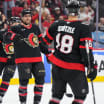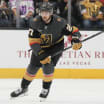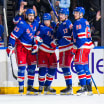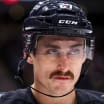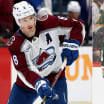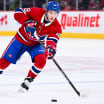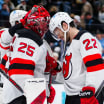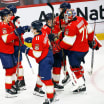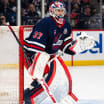Unmasked: 'Recoil' technique helps Ullmark to best season for Bruins
Goalie opening mind to drifting backward leads to NHL highs in wins, GAA, save percentage
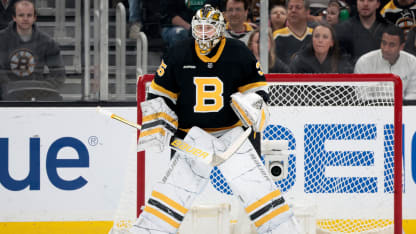
In doing so, he had to abandon half of what many in the goaltending world still see as a foundational part of the position and how best to play it: Being set and square before the shot.
Ullmark strives to get square to a shooter, but instead of being set when the shot is loaded up, he now drifts slightly backward, a movement Bruins goaltending coach Bob Essensa calls "recoil."
After some initial hesitation when he arrived as a free agent last season, Ullmark credits the change for playing a big role in helping him lead the NHL with 36 wins (36-5-1), a 1.92 goals-against average and .937 save percentage.
"I was frustrated because [Essensa] wanted me to move and I wanted to be stopped and set because I felt that's where I make my reaction saves," Ullmark said. "And then I had one game, just one game, when everything clicked last season, where I got a little taste of it, and I told him 'This is nice' and then I started easing up a little bit on it. I was stubborn, like, 'My way works, my way got me to this point, so why would I start changing these things in my game.'"
The concepts behind that feeling were reinforced during the offseason while listening to an interview on the "InGoal Radio" podcast with goalie Henrik Lundqvist, who played 15 seasons for the New York Rangers before retiring Aug. 20, 2021.
"I listened to that and a lot of the things me and Bob talked about last year just made sense and I was like, 'You know what? I'm going to try to incorporate this,'" Ullmark said.
During the explanation, Ullmark pointed to his playing partner, Jeremy Swayman.
"He loves it that I was so against it and now I'm a big believer of it," Ullmark said. "The recoil. The flow."
Swayman arrived in Boston as a rookie in 2020-21, one season before Ullmark, but played with backwards momentum at the University of Maine because Alfie Michaud, the Black Bears goaltending coach, advocated for it. His four shutouts this season are tied for fourth in the NHL, and he ranks fourth in save percentage (.921) and third in GAA (2.19) among goalies who have played at least 30 games.
"I was lucky implementing it in my game early on," Swayman said. "But as soon as you think you've mastered it, you get humbled pretty quick, so it's definitely a feel thing and something we work on every day."
The idea of drifting backward in the crease isn't new when it comes to playing against rush chances. Goalies have long tried to start above the crease and time their retreat to match the pace of the attack. What makes the Bruins approach unique is doing it on in-zone plays, when others traditionally emphasize being set because of fears a goalie in motion won't be able to react as well.
"I'll never argue with being square, but I want our guys to beat the pass and when the guy goes to lean on his stick, just have a little bit of recoil," Essensa said. "You're still staying square. It's just a few inches to get yourself out of mud a little and for whatever reason it's been great to all the goalies that have come through here and right now it's working for both our goalies."
The subtleness of the recoil movement helps, Essensa said. Goalies used to come out of the crease and skate backward, forcing them to transfer weight from one side to the other, which added to the risk of getting caught on the wrong foot and delaying their lateral push when a pass was made. The version the Bruins employ allows the goalie to keep weight balanced on both skate edges to remain mobile in either direction, dependent on the movement of the puck.
"I'm not a physics major, but if anything, you're giving yourself a little split-second longer to react and if you don't contain pucks, or the pucks go to bad areas, now you're already in motion," Essensa said. "And that's another physics thing: If you're already in motion, you're going to stay in motion, so that's my thought process going into it. It's something Tuukka [Rask] and I did and Tim [Thomas] was great for it too, so it's certainly not new. But it's something that had maybe gone out of the position a little."
Lundqvist didn't play with backward flow, except on breakaways, but played a lot deeper in his crease. Hearing him talk about how it gave him more time to react to shots and shortened the distance he had to move side to side resonated with Ullmark.
"A lot of doubts that I had just started to make sense more and then I started working on it with the goalie coach in Modo (of Sweden's second-tier league HockeyAllsvenskan) in the summer, Andreas Eriksson, because he's a big believer in the same thing," Ullmark said. "We sat down and had this whole conversation, and it was just like this big revelation, like, 'This is actually something that makes a lot of sense.' It does."
Essensa believes the recoil process can help reduce wear and tear on goalies. Ullmark said he feels better physically this season.
"When you move around the crease, there's energy involved, and it's all about utilizing that movement energy and putting it in the right place, the right spots," Ullmark said. "Because once you start getting set and you're stuck, you have to create energy to create power and create speed, and it's almost like you're turning off your engine, and then you're starting and turning off the engine and you're starting again. So, there's a lag between stopping and starting."
There's been little lag in Ullmark's game this season, just an inverse relationship between the direction he moves in the crease and his career trajectory.
